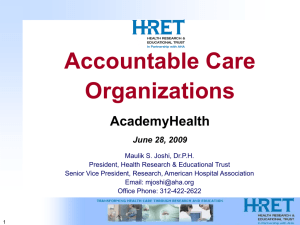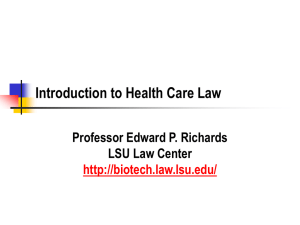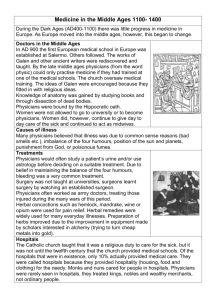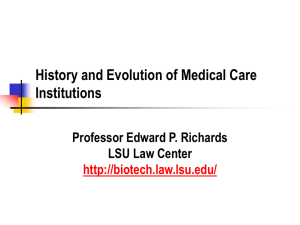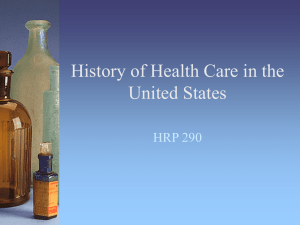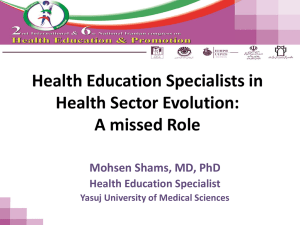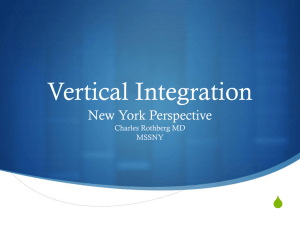Introduction to Health Care Law Professor Edward P. Richards LSU Law Center
advertisement
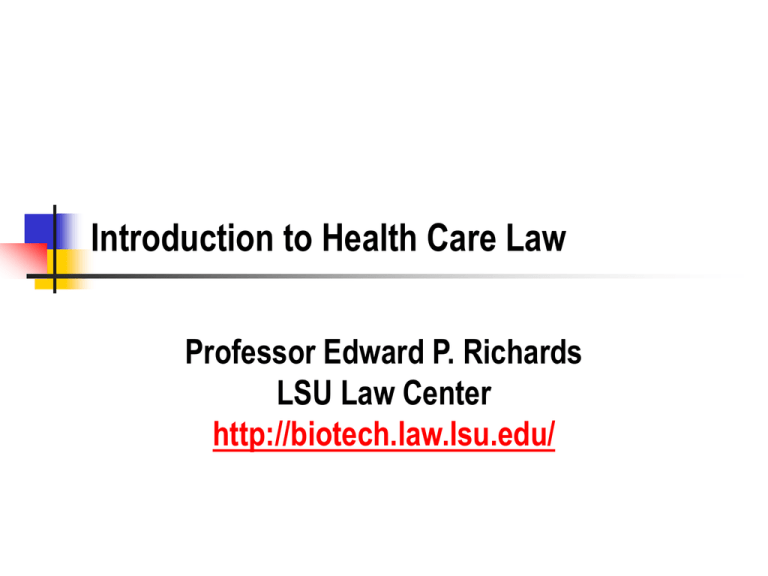
Introduction to Health Care Law Professor Edward P. Richards LSU Law Center http://biotech.law.lsu.edu/ Key Issues Scientific medicine is about 120 years old Technology based medicine is less than 60 years old Doctors are not scientists and many do not practice scientific medicine. There is no stable model for medical businesses, leading to constant change and unending legal problems. Health care finance shapes medical care and is a huge mess 2 Critical Dates in Medicine 1400s Birth of hospitals Places where nuns took care of the dying No medical care – against the church’s teachings No sanitation – assured you would die 4 Early 16th Century Paracelsus Transition From Alchemy 5 Mid 16th Century Andreas Vesalius Accurate Anatomy 6 Early 17th Century William Harvey Blood Circulation – the body is dynamic, not static 7 1800 Edward Jenner Smallpox and the notion of vaccination First important preventive treatment 8 1846 William Morton - Ether Anesthesia 9 1849 Semmelweis Childbed Fever and sanitation Controlled Studies 10 1854 John Snow Proved Cholera Is Waterborne Basis of the public sanitation movement 11 1860-1880s Louis Pasteur Scientific Method Simple Germ Theory Vaccination For Rabies Pasteurization to kill bacteria in milk 12 1867-1880 Joseph Lister Antisepsis – surgeons should wash their hands and everything else, then use disinfectants Listerine 13 1880s Koch Modern Germ Theory Organic Chemistry Birth of the modern drug business The real starting point for scientific medicine 14 1850s - 1900s Sanitation Movement - Modern Public Health Sewers Clean drinking water Land use laws to protect against industrial dangers in residential neighborhoods 15 Schools of Medical Practice - pre-science (1800s) Allopathy Opposite actions Toxic and nasty Homeopathy Same action as the disease symptoms Tiny doses Less dangerous Naturopaths, chiropractors, osteopaths, and several other schools 16 Most Medical Schools Are Diploma Mills No bar to entry to profession Small number of urban physicians are rich Most physicians are poor Cannot make capital investments Training Medical equipment and staff Courts and legislatures see no reason to favor one group Physicians unsuccessfully push for state regulation to create a monopoly 17 Legal Consequences No Testimony Across Schools of Practice Different from Medical Specialties Surgery, Internal Medicine, Pediatrics All Same School of Practice - Allopathy All Same License Cross-Specialty Testimony Allowed Still important with the rise of alternative/quack medicine In many states, there are no legal protections if you go to an alternative medical practitioner 18 Transition to Modern Medicine and Surgery 19 The Business of Medicine Mid to Late 1800s Physicians are Solo Practitioners Most Make Little Money Have Limited Respect 20 Surgery Starts to Work in the 1880s Surgery Can Be Precise - Anesthesia Patients Do Not Get Infected - Antisepsis First time there is an objective benefit to going to a doctor and hospital 21 Licensing and Education Once there are objective differences (people live) between qualified and unqualified docs, people care about licensing and credentialing Licensing starts to make sense when there is a reason to differentiate between practitioners Limits market entry and competition Licensing and credentialing has market value You can make more money with better training You can make more money with better equipment and facilities 22 Hospital-Based Medicine Started with surgery Medical laboratories Bacteriology Microanatomy Radiology Services and sanitation attract patients Internal medicine Obstetrics patients 23 The Tipping Point About 1910, going to the doctor and particularly the hospital shifted from being more dangerous than avoiding them to increasing your chance of survival. Corporate Practice of Medicine - 1920s Physicians Working for Non-physicians Concerns about professional judgment Cases from 1920 read like the headlines Banned in most states Real concern was laymen making money off physicians 25 Physician Practices Shaped by corporate practice laws Sole proprietorships Partnerships Mostly small Some large groups First organized as partnerships Then as professional corporations 26 Impact of Corporate Bans Physicians do not work for non-governmental hospitals Contracts governed by medical staff bylaws Sham of “buying” practices Physicians contract with most institutions Charade of captive physician groups Managed care companies contact with group Group enforces managed care company’s rules Physicians can be as ruthless as anyone 27 Post WW II Technology Ventilators (polio) Electronic monitors Intensive care Hospitals shift from hotel services to technology oriented nursing 28 Post World War II Medicine Conquering microbial diseases Vaccines Antibiotics Chronic diseases Better drugs Better studies Childhood leukemia 29 The Evolution of Hospitals From Nuns to MBAs Old Days Charitable immunity No independent liability for nurses No liability for physician malpractice 31 Reformation of Hospitals Paralleled changes in the medical profession Began in the 1880s Shift from religious to secular Began in the Midwest and west Not as many established religious hospitals Today, religious orders still control A majority of hospitals 32 After Professionalization Demise of charitable immunity Liability for nursing staff Negligent selection and retention liability for medical staff 33 Hospital Staff Privileges Physicians are usually independent contractors Hospitals are not vicariously liable for independent contractor physicians Hospitals are liable for negligent credentialing and negligent retention Hospitals can be liable if the physician is an ostensible agent 34 Joint Commission on Accreditation of Hospitals 1950s Now Joint Commission on Accreditation of Health Care Organizations American College of Surgeons and American Hospital Association Split the power in hospitals Medical staff controls medical staff Administrators control everything else Enforced by accreditation 35 Contemporary Hospital Organization Classic corporate organizations CEO Board of trustees has final authority Part of conglomerate Medical staff committees Tied to corporation by bylaws (contract) Headed by medical director Constant conflict of interest/antitrust issues 36 Medical Staff Bylaws Contract between physicians and hospital Not like the bylaws of a business Terms of the contract Selection criteria Contractual due process for termination Limits on privileges Negotiated between medical staff and hospital board 37 Hospital Economics Old days More patients meant more money More docs to admit patients Insurance was so generous it cross-subsidized indigent care Now Hospital beds were closed to save money Insurance and government pay is very limited - no cross-subsidy Under-insured or over-cared-for patients cost money 38 Managed Care Pressures on Docs When is denying care cheaper? What is the timeframe issue? Insurers increasingly control the patients Employee model Contractor model De-selection Financial death No due process 39 Specialty Hospitals Complex care is safer when regionalized Specialty hospitals can provide better care at lower prices Do not need to provide money losing services Do not take uninsured patients Shift the most valuable patients from community hospitals Dramatically increase unnecessary surgery 40 Drugs and Medical Devices Covered later in the course 41
